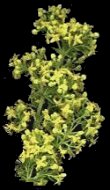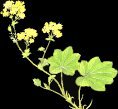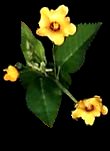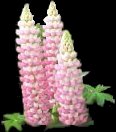|
**disclaimer: If any of the images belong to you and if you want credit or want them removed please email me**
MEANINGS & LEGENDS OF FLOWERS (L)

 Lady's Bedstraw
Lady's Bedstraw
Galium verum
Family: Rubiacaea
Common Names: ~Our Lady's Bedstraw~ ~Yellow Bedstraw~ ~Maid's Hair~ ~Petty Mugget~ ~Cheese Renning~ ~Cheese Rennet~
The name of this genus, Galium, comes from the Greek word ~gala.~ Native to the British Isles, Europe, Asia and Mesopotamia, it is a medicinal plant and also produces a red dye in its roots, used to dye wool. Because of its bright yellow blossoms, it is also known as ~Maid's Hair.~ Also called ~Petty Mugget,~ from the French ~petit muguet,~ ~a little dandy.~
The common name, ~Lady's Bedstraw~ is derived from its use in the olden days, when it was dried and used for making bedding. According to a Christian legend, this was one of the ~Cradle Herbs,~ meaning it was the hay used in the manger at Bethlehem, where Jesus was born.
The dried leaves smell of fresh mown hay. Flowers will coagulate boiling milk and was used from the time of the Greeks to the 1800s as a means of curdling milk in cheese manufacture. It was called ~Cheese Renning~ in the 16th century. The people in Cheshire, where the best cheese is made, use it in their rennet. Not used for cooking. Bedstraws are food for caterpillars of the Bee Hawk moth.

 Lady's Mantle
Lady's Mantle
Alchemilla vulgaris
Family: Rosaceae
Common Names: ~Lion's Foot~ Bear's Foot~ ~Dewcup~Lion's Foot~ ~Bear's Foot~ ~Nine Hooks~ ~Leontopodium~ ~Stellaria Dewcup~ ~Breakstone~ ~Lion's Foot~ ~Stellaria~ ~Woman's Best Friend~
French Name: ~Pied-de-lion~
German Name: ~Frauenmantle~
Lady's mantle is native to most of Europe, northwest Asia, northeast USA and Greenland. The name Lady's Mantle in German ~Frauenmantle,~ was first given by the 16th-century botanist, Jerome Bock, known by the Latin version of his name; ~Tragus.~ It appears under this name in his famous History of Plants, published in 1532, and Linnaeus adopted it.
In the Middle Ages, Lady's Mantle was dedicated to the Virgin Mary, hence the name ~Lady's Mantle,~ the lobes of the leaves resemble the scalloped edges of a mantle.
In mediaeval Latin it is called ~Leontopodium~ meaning ~lion's foot~ because of its spreading root-leaves, and this gave it's French name, ~Pied-de-lion.~ It's scientific name Alchemilla is derived from the Arabic word, ~Alkemelych~ meaning ~alchemy~ was given because of the powers of the plant.
The folk name, ~Dewcup~ comes from the special way that dew collects on the leaves of Lady Mantle. These drops of moisture were considered a holy water which could cleanse all illness. During the Middle Ages, these magical dew drops were used by alchemists in many of their mystical potions.
Lady's Mantle has long been a healing herb for women, said to regulate and the menstrual cycle and ease menopause. Tea can be made from dried leaves or stems. Lady's Mantle is a feminine flower. It is said that if a female feels her femininity threatened in any way, then bring a vase of these flowers into the house and the feminine spirit will feel strengthened. Lady's Mantle was carried to attract love.

 Larkspur
Larkspur
Delphinium sp.
Family: Ranunculaceae (Buttercup family)
Common names: ~Low Larkspur~ ~Little Larkspur~ ~Montane Larkspur~ ~Lark's Heel~ ~Lark's Claw~ ~Elijah's Chariot~
Larkspur was discovered in the mid-1800's across North America's prairie lands. It is a tall and slender flower, with a wide color range of white, blue, purple, red and various shades of green, which account for the species Latin name meaning ~to become green. ~
According to legend, during the time of the famous Gold Rush of 1849, the Crane boys, a pair of mischievous youths searching to strike it rich, began an adventure from their midwest home to the California coast. Throughout the journey across the midwestern plains, the boys encountered countless waves of poisonous snakes and other harmful species. To combat these horrific attacks, the Crane boys used tall larkspur ~a stout and lengthy species of the flower,~ as a guarding device and defense tool while they rested.
The larkspur and the delphinium are close relatives; both are named for the shape of their flowers. The spur, looks like parts of the lark; hence ~Larkspur~ ~Lark's Heel~ and ~Lark's Claw.~ Its more delicate foliage differentiates it from the delphinium.
Larkspurs symbolize lightness and swiftness.
* See Delphinium

 Laurel
Laurel
Laurus nobilis
Family: Lauraceae
Bay is the common name used for laurel. Laurel has been the symbol of Glory and Fame since ancient times, when crowns of Laurel were placed upon the heads of triumphant soldiers and ~poets laureate.~
As the bay tree, the true laurel of the Ancients, is scarce in England, substitutions such the common cherry laurel, the Portugal laurel, the Aucubaand others are often used.
Great protective powers were also ascribed to the bay laurel -- if you stood near a laurel tree, you couldn't be struck by lightning or suffer from the spells of evil witches.
Among the pagan Romans, the laurel leaf was sacred to the sun god Apollo. In Christianity, it came to symbolize the triumph of Humanity as represented by the Son Man.
English traditions hold that if two lovers pluck a laurel twig and break it in half, each keeping a piece, they will be lovers forever.
*See Bay

 Lavender
Lavender
Lavandula angustifolia
Family: Lamiaceae Lindl.
Common Names: ~Spike~ ~Elf~ ~Nard~ ~Nardus~
Lavender is a hardy, aromatic evergreen shrub, native to the Mediterranean. The botanical name, ~Lavandula~ comes from the Latin ~lavare,~ meaning ~to wash.~
Lavender has been around for several thousand years, dating back to the times of the ancient Greeks. The Romans were responsible for the spread of lavender throughout Europe, taking it with them everywhere they went, in order to have local supplies of lavender oil which they used extensively in many ways. It was a favored herb in ancient Greece and Rome and was used in bath water for both its scent and therapeutic values. During the Middle Ages, it was considered to be the ~herb of love.~ Because of its clean, fresh scent and insect-repellent properties, it was a popular strewing herb. It was an ingredient in smelling salts and was used to disinfect wounds during war time.
Lavender has been a popular rock and flower garden plant. Linen and clothing were thrown over the bushes to dry and absorb the sweet smell of the lavender. It can be used dried, loose or on the stems. Lavender potpourri has been used to keep moths away and to enhance the aroma of rooms, closets and linens. For centuries lavender was a staple herb in many kitchens.
Tea made from the flowers helps releive headaches. A facial wash from lavender flowers stimulates cell growth and helps against acne. Also used as a sedative and disinfectant. Lavender has a strong antibacteriual action and helps heal cuts, burns and stings. Was used extensively as an antispectic in World Wars I and II.
During the 13th and 14th centuries, lavender was grown in monastery gardens for medicinal purposes. The glove makers of Grasse, France used lavender oil to scent leather and reportedly, they seldom caught the plague. People began to carry posies of lavender to ward off illness.
Traditionally, sprigs of lavender were placed in the hands of women in labor. Squeezing the fragrant bundles was said to give them strength and courage during childbirth. Lavender posies were given to newly-married couples to bring good luck and sprinkling dried lavender flowers in the home is said to bring peacefulness.
Folk magic is associated with lavender. Carrying or inhaling lavender was reported to enable one to see ghosts. A sprig of lavender carried in combination with a sprig of rosemary was said to preserve chastity. Lavender was also worn as protection against the evil eye.
Lavender is one of the sacred herbs of midsummer. The Virgin Mary is said to have dried her newborn's swaddling clothes by spreading them on a bed of wild lavender.

 Lemon Balm
Lemon Balm
Melissa officinalis L.
Family: Labiatae
Common Names: ~Heartís Delight~ ~Balm Mint~ ~Bee Balm~ ~Blue Balm~ Cure-all~ ~Garden Balm~ Honey Plant~ ~Sweet Balm~ ~Sweet Mary Balm~ ~Melissa~Dropsy Plant~
French Name: ~Citronelle~
German Name: ~ Zitronmelisse~
Lemon Balm was known as the ~Elixir of Life.~ It is said that the plant is named after the Greek nymph Melissa, protectress of the bees. The name Melissa is said to be an abbreviation of the Latin name ~melissophyllum~ meaning ~bee plant or leaf.~ ~Melissa~ being a Latin derivation of the Greek word for ~honey bee.~ ~officinalis~ indicates that the plant is medicinal in nature.
Native to southern Europe and northern Africa, Lemon Balm is now cultivated throughout the world. Londoners of Elizabethan times would carry small bouquets, called ~Tussie Mussies,~ filled with aromatic herbs and flowers, including Lemon Balm, which they would frequently sniff to get rid of stench of the unsanitary conditions.
It is one of the earliest known medicinal herbs, dating back to at least 2000 years and was associated with nervous disorders, the heart and emotions. The ancient Greeks used this plant for its soothing smell and its medicinal properties. Lemon Balm is antibacterial and anti viral in nature. It is also a sedative herb, lowering fever, relaxing spasms and improving digestion.
People of the Mediterranean used this herb to attract honey bees. Till today Bee keepers often rub the inside of a new hive with the leaves to encourage a new swarm to stay.
It is used in fruit salads, vegetables and herb vinegars. It is also used as a garnish. Freeze leaves into ice cubes to serve in lemonade. The leaves are also used for polishing wood. Dried, it is used in potpourri.

 Lettuce
Lettuce
Lactuca sativa var. crispa.
Family: Asteraceae
Common Names: ~Leaf~ ~Loose-Leaf Lettuce~ ~Cos~ ~Romaine~ ~Crisphead~ ~Butterhead~ ~Stem~ ~Asparagus Lettuce~
Lettuce is one of the oldest known vegetables and is native to the Mediterranean area. It is a member of the sunflower family. There are five distinct types of lettuce: ~Leaf~ or ~Loose-Leaf Lettuce,~ ~Cos~ or ~Romaine,~ ~Crisphead,~ ~Butterhead~ and ~Stem~ or ~Asparagus Lettuce.~ The main European producers of lettuce are Spain, Italy, France and the Netherlands.
Its Latin name ~Lactuca~ means ~milk~ due the gel it exudes when cut. Some people believe that it was due to lettuce's use once as a sedative.
In the 1600s, John Winthrop Jr. brought packets of lettuce seed to America from England. Lettuce was grown by the Assyrians, Greeks and Egyptians in the olden days.
The Romans believed it had medicinal properties. It was believed to be a powerful aphrodisiac and possess child-bearing powers. It was served at feasts and weddings and also thought to prevent drunkeness. In England the country folk believed that planting lettuce in the garden could prevent conception.
Till the 1920s, ~Iceberg~ lettuce was called ~Crisphead.~ It was renamed when California began transporting large quantities of lettuce underneath mounds of ice to keep them cool. 25% of all iceberg lettuce is made into fresh-cut salads.
Romaine lettuce was named by the Romans who believed it had healthful properties. Emperor Ceasar Augustus put up a statue praising lettuce because he believed it cured him from an illness.
In Europe, Romaine lettuce is called ~Cos,~ named after the Greek island of ~Kos~in the Aegean Sea.
In the United States, lettuce is the second most popular fresh vegetable. Americans eat about 30 pounds of lettuce every year. In 1988, more than 153,000 acres of lettuce were harvested in California. Lettuce is packed in the field.Darker green lettuce leaves are more nutritious than lighter green leaves.

 Liatris
Liatris
Liatris callilepis
Family Asteraceae (Aster family)
Common Names: ~Purple Poker~ ~Kansas Gay Feather~ ~Button Snakeroot~ ~Blazing Star~ ~Spire~ ~ Spike~
~Gayfeather ~
Liatris resembles a bottle-brush. It's foliage is dark green and grass-like, and stems are woody. Flowers have a vase life of 7 to 8 days.

 Lianthus
Lianthus
Linanthus spp.
Family: Polemoniaceae
Common names: ~Showy Linanthus~ ~Sand-Blossoms~ ~ Mojave Linanthus~ ~Golden Linanthus~ ~ Sierra Nevada Linanthus~ ~Mustang Clover~ ~Deserttrumpets~
Native of the Pacific Coast, Lianthus has dense clusters of white, trumpet-shaped flowers tinged with pink or lavender. It is an annual herb that is native to California and is endemic (limited) to California. It was ranked by CNPS as a rare plant ~1997.~

 Lily
Lily
Lilium Candidum
Family: N.O. Liliaceae
Common Names: ~Asiatic Lilies~ ~Oriental Lilies~ ~Madonna Lily~
Lilies grow all around the northern Hemisphere. They are divided into five groups.
Asiatic Lilies
Oriental Lilies
Tiger Lilies
Trumpet Lilies
Turks Cap Lilies
Oriental Lilies are the largest of the Lily family, ranging between 6 - 10" in diameter. The lily gets it's name from the Greek name ~leirion~ and the Roman name ~lilium~.
Lily is considered to be the most significant flower for the Christians and is a symbol of purity, being associated with virgins, it became known as the ~Madonna Lily.~ Until the 16th century the Madonna lily was the only garden variety known.
The white Madonna lily is considered the special flower of the Holy Virgin, for Christian lore tells that the lily had been yellow until the day the Virgin Mary stooped to pick it. Another legend tells that the lily sprang from Eve's tears, when expelled from Eden, she learned that she was pregnant.
The Lily was a popular flower in ancient Jewish civilization and is mentioned in the old and new Testaments. With Christianity, the lily became the symbol of chastity and virtue. Through its association with the Virgin Mary, it also became the symbol of virgin martyrs and saints. In both the Christian and pagan tradition, the the Lily is a symbol of fertility. In ancient Greek and Roman marriage ceremonies, the priest placed a crown of lilies garnished with ears of wheat, on the brides head, as a symbol of purity and abundance. Lilies are also a symbol of death, and were placed on graves.
Lily were discovered in a villa in Amnisos, Crete, which dates from the Minoan Period, about 1580 B.C. The lily was the Minoan sacred flower, a special attribute of the Great Minoan Goddess Britomartis or Dictynna who had her origin in Neolithic times. She maintained her supremacy in Crete until the mysterious cataclysm that befell Minoan civilization in the middle of the 16th century B.C. when her cult was gradually assimilated into the religion of the Greeks and she became the precursor of Greek Artemis.
Lily was dedicated to the goddess Hera, the wife of Zeus. Legend has it that when Zeus fathered Hercules with the mortal woman Alceme, he wished his son to partake more fully of divinity. To attain this, he had the baby brought to Hera after he drugged her to sleep. Then he placed the baby at her breast and Hercules nursed. Hera awoke in horrified surprise and flung the baby from her. Some of her milk gushed across the heavens and formed the milky way. A few drops fell to earth and from those drops sprang the first lilies.
According to a Roman legend, when Venus rose from the sea-foam she saw a lily and was filled with envy at the whiteness and beauty of the lily. Seeing it as a rival to her own beauty she caused a huge and monstrous pistil to spring from the lily's snow-white center. This myth accounts for the the lily being associated with Venus and the Satyrs who are the personification of lustful ardor. In Rome, lilies were known as ~Rosa junonis,~ or ~Juno's rose.~
The Lily was a symbol of nobility. Lily is an emblem of summer and abundance according to the Chinese and was the holy flower of the ancient Assyrians. In medieval times, white lilies were often used for medical treatments. Modern science, has proven these lily remedies to be only myths.
Other folklore tells us that lilies, spontaneously appeared on the graves of people executed for crimes they did not commit. Some believe that planting lilies in a garden will protect the garden from ghosts and evil spirits. In China, the day lily is the emblem for motherhood. The Romans were said to cure corns with the juice from lily bulbs. Spaniards believed that eating a lily's petals would restore someone who had been transformed into a beast back into human form. In medieval times, lilies symbolized feminine sexuality. To dream of lilies in spring foretells marriage, happiness and prosperity. To dream of them in winter indicates frustration of hopes, and the premature death of a loved one.
The average vase life of a stem of lilies is 14 - 20 days. Individual blooms generally last 4 - 5 days.
For a longer flower life, remove anthers from open flower before yellow pollen stains white petals. Gently run of pollen stains with cotton. If you get lily pollen on your clothing, use a dry toothbrush, chenille stem or dry towel to brush off. Do not brush off with your hands as this rubs pollen deeper into fabric.
White lilies symbolize innocence, purity and sweetness. Yellow lilies express gratitude and gaiety.
*See Easter Lily

 The Lily of the Valley The Lily of the Valley
Convallaria magalis (LINN.)
Family: N.O. Liliaceae
Common Names: ~Ladder to Heaven~ ~Jacob's Tears~ ~May Lily~ ~Convallaria~ ~Our Lady's Tears~ ~Convall-lily~ ~Lily Constancy~ ~Male Lily~
Its scientific name, ~Majalis~ or ~Maialis~ means ~that which belongs to May.~ Old astrological books place the plant under the dominion of Mercury, since Maia, the daughter of Atlas, was the mother of Mercury or Hermes.
A French legend tells of a holy man known as Saint Leonard, a close friend of King Clovis, who lived in the Vienne Valley near Limoges in 559 AD. Saint Leonard, a brave and fearless fighter, wanted to spend his days communing with God. So he took permission from the king to go live the life of a hermit in the woods. In the same woods also dwelled the dragon Temptation. Saint Leonard was at prayer and did not hear the dragon when it demanded that Saint Leonard leave the woods. The evil dragon burned down Saint Leonard's hut with his fiery breath. Much blood was spilled as terrible battles took place between them. Saint Leonard drove the evil dragon further into the woods until the dragon disappeared altogether. Poisonous weeds began to grow where the dragon spilled his blood, but beds of lilies of the valley sprang up wherever the ground was sprinkled with Saint Leonard's blood to mark the places of their battles. These woods, till today are known as St. Leonard's Forest
The lily of the valley signifies the return of happiness. Legend tells of the affection of a lily of the valley for a nightingale that did not come back to the woods until the flower bloomed in May.
It is a symbol of humility in religious painting. Lily of the valley is considered the sign of Christ's second coming. The ~Songs of Solomon~ in the Bible mentions the ~Lily of the Valley.~ According to a Christian legend, Mary's tears turned to ~lily of the valley~ when she cried at the cross and because of this it is also known as ~Mary's Tears.~ The power of men to envision a better world was attributed to the lily of the valley.
Lily of the valley has been used for medicinal purposes. It was believed to strengthen memory, to restore speech and as a liquor smeared on the forehead and the back of the neck, to make one have good common sense. All parts of the plant are considered poisonous, despite it's alleged powers.The leaves yield a green dye, with lime water.

 Limonium
Limonium
Limonium sinuatum
Family: Plumbaginaceae
Common Name: Statice
Limonium is an ancient Greek name derived from the word for ~meadow.~
Limonium is recommended for use in dried arrangements.
*See Statice

 Hawaiian name: Ilima
Hawaiian name: Ilima
Sida fallax
The yellow Ilima flower is the ~Flower of Oahu,~ popularly used for leis, was once reserved for the Hawaiian royalty ~the Ali'.~
The flowers were used as a laxative for children, and the root bark mixed with the flowers was used as an asthma remedy.

 Lotus
Lotus
Nelumbo nucifera
Family: Liliaceae
Lotus is sacred to all Oriental and Asian cultures. It is used in many works of art especially in India. The Lotus flower has represented divine female fertility in the Orient for over 5,000 years.
The Chinese celebrate the lotus flower in July, the symbol of perfection and purity. They call it ~the flower of gentlemen.~ The blue lotus was sacred to the Egyptians because it was associated with the sun god, ~Ra.~
According to Bhuddhism, Lord Buddha designated an important document called as the ~Lotus Sutra.~ To him, the Lotus was very beautiful and its large white bloom was so outstanding in muddy water that it symbolized the enlightened one in a world of ignorant beings. Therefore, the official symbol of Buddhism is the White Lotus Flower. The closed lotus represents potential. Depending on the number of petals, the lotus' symbolism changes. With eight petals, it represents cosmic harmony, with 1,000 petals it means spiritual revelation.
Asians consider it to be a valuable food. The the roots and seeds can be eaten. The Lotus seed is sweet and is used to make a sweet paste for a Chinese dessert, called ~Moon Cake,~ served during the Autumn Festival. During the Chinese new year, lotus seeds are cooked and served to visiting relatives. The lotus leaves are used to wrap up rice for steaming.
The lotus is so highly venerated as a plant that it appears symbolically in architecture, paintings and held by Egyptian mummies. It was sacred to the Greeks as a symbol of beauty and in Hindu tradition, a golden lotus bore the god Brahma. The lotus is the emblem of paradise in Japan. To the Hindus it was a symbol of the solar matrix, the maternal womb from which the sun rose to renew the word. In ancient Egypt similar concepts were symbolized by the rose of Isis, which replaced the original lotus when the cultivation of flowers spread to Egypt.
Lotus symbolizes Purity, Resurrection, Evolution, Potential.

 Lupine
Lupine
Lupinus polyphyllus
Family: Fabaceae (Pea family)
Common Names: ~Wild Pea~ ~Wild Bean~ ~Blue Pea~ Old Maid's Bonnet~ ~Quaker-Bonne~ Sundial~
The word ~lupine~ comes from the Latin word ~lupus,~ meaning ~wolf.~ It was thought that the lupine ~wolfed~ down the nutrients from the ground. However, it actually fertilizes the land around it.
There are more than 200 species of lupine. New Brunswick has the most diverse and abundant population of lupines in the world.
Lupine seeds are rich in protein and can be eaten. It can be used as fodder for cattle. Lupines are tough and can be found growing in dry places, like road sides and vacant fields.
*See Bluebonnet
|


Copyright © Pinkie D'Cruz 1998
Friday, January 16, 1998


|
